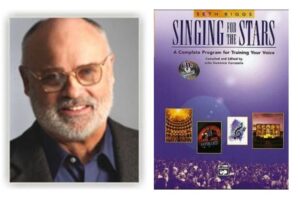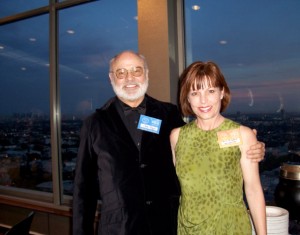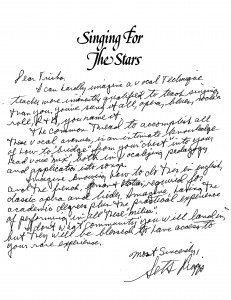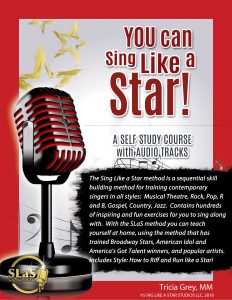SLS or Speech Level singing is a pedagogy originated by Seth Riggs. The focus of Speech Level Singing is transitioning through the primo passaggio or first bridge without either straining (pulling chest voice too high) or flipping (an abrupt abduction or opening of the vocal folds resulting in a breathy vocal quality). The Speech Level Singing methodology produces a natural speech-like sound by encouraging a stable laryngeal position throughout the singer’s entire range.
Seth Riggs says:
“Generally, when you speak in a quiet, comfortable manner, the outer muscles do not interfere with the functioning of your larynx. That’s because tone is not your main concern–communication is. Therefore, your larynx is allowed to rest in a relatively stable, or what we call a speech-level position. This is the ideal vocal condition or posture with which to sing.
“Speech-level signing allows you to sing with the same comfortable, easily produced voice you use or should use, when you speak. No matter if you sing high or low, loud or soft, nothing feels different in your throat or mouth. Your tone and the words you sing always feel natural to you, and sound natural to your audience.”
SLS trains you not to “reach” for high pitches which means the larynx stays at a speech level position. This allows the vocal cords to adjust as the pitches go up or down without disconnecting. That means the cords stay connected, so you have no breaks, cracks, breathiness or falsetto no matter how high or low you sing. There’s no interruption in the tone quality because the voice is balanced. There’s no tension or squeeze from the external (or outer) neck muscles.
The most famous singer who studied Speech Level Singing was Michael Jackson. Others include Ray Charles, Barbra Streisand, Prince, and Stevie Wonder.
Speech Level Singing technique develops the “mix” voice- a blend of chest and head voice that makes you sound like you have one, unified, powerful sound from the lowest to the highest notes.
Every singer needs powerful high notes- but without the strain of pushing the chest voice upward. Every singer needs to develop the mix. The contemporary mix sounds like belting, but feels easy! This is an exciting sound, and is the vocal quality most in demand in today’s music business. Whether you sing pop, R&B, rock, gospel, country, or Musical Theatre, this is the sound you want to develop.
Sing Like a Star Studio founder Tricia Grey, MM was trained in the Speech Level Singing (SLS) technique by Maestro Seth Riggs himself, who also taught Michael Jackson, Stevie Wonder, Prince, Barbra Streisand, and many other stars. Tricia studied privately with Maestro Riggs throughout the 1980’s and 1990’s. She was encouraged by Seth to begin teaching when she was only 20 years old.

Tricia was very active in the SLS (Speech Level Singing) organization and was a Level 5 (highest level) instructor. She wrote a Speech Level Singing training manual that was used to train SLS teachers all over the world. She incorporates many aspects of Speech Level Singing in her teaching and online courses.
Here is what Seth Riggs says about Tricia Grey:
Dear Tricia: I can hardly imagine a vocal technique teacher more eminently qualified to teach singing than you. You’ve sung it all- Blues, Rock-n-Roll, R&B, Jazz, Opera, you- name-it. The common thread to accomplish all these vocal avenues is your intimate knowledge of how to bridge the registers from chest to head voice. Your students will be extremely blessed to have access to your rare experience.
Most Sincerely, Seth Riggs.
Here is what Tricia says about Speech Level Singing (SLS) as it relates to her approach, which is known as the Sing Like a Star method.
 “I, like so many teachers and singers, definitely feel extremely grateful to have studied Speech Level Singing, with Seth Riggs himself, when I was a young singer and voice teacher. Many teachers in the 1980’s were either in the classical/ operatic camp, or they were teaching a very unhealthy approach to belting. Very few were teaching contemporary singing by mixing the registers, as Seth did.
“I, like so many teachers and singers, definitely feel extremely grateful to have studied Speech Level Singing, with Seth Riggs himself, when I was a young singer and voice teacher. Many teachers in the 1980’s were either in the classical/ operatic camp, or they were teaching a very unhealthy approach to belting. Very few were teaching contemporary singing by mixing the registers, as Seth did.
Speech Level Singing was a wonderful foundation to build my singing and teaching career on. Seth taught me that the primo passaggio or first bridge (transition between chest voice and head voice) should start somewhere between Ab4 and B4 in the female voice, depending on the size of the vocal folds. The classical teachers I worked with before Seth would only bring the head voice all the way down and discourage the chest voice, which means the low notes are weak and breathy.
I appreciated learning to sing with a natural and unaffected vocal tone that was right for the kinds of bands I was singing with in Los Angeles- rock, pop and R&B bands.
Seth himself encouraged me to start teaching when I was about 20 years old, and he even sent me my first students, demonstrating his great faith in my abilities.
From the late 1990’s through 2010, I was part of the Speech Level Singing organization- an international group of teachers trained in Speech Level Singing, and I even wrote a teacher training manual for the SLS organization, designed to train others to teach the Speech Level Singing approach.
However, as time went on, I became increasingly aware that some of the SLS tenets were not really based on vocal science. Phrases like “the cords zip up”, (they do not), and “keep the cords together” (the vocal folds vibrate open and closed hundreds of times per second, so they really cannot stay together constantly), were troubling. And then there was the fact that every SLS teacher I observed would immediately start trying to get singers to mix, whether they had anything to mix with or not. Singers with no development of the lower register were immediately singing Long Scales with a breathy, tiny sound and then celebrated for “mixing”. Essential skills like vibrato, flexibility, and dynamics were not even addressed.
Additionally, the entire lexicon of scales available numbered about six. Six scales with various combinations of sounds comprised the sum-total of every single lesson.
Granted, those tools were very good at solving registration issues- the problem of voice breaks and registration imbalance. Though these issues are vital and fundamental, they are just a starting point to good singing.
As a voice teacher, I felt I owed my students more.
So, building on my great education in Speech Level Singing, (along with a Master’s Degree in Voic, extensive study of vocal science, and many years in the trenches as a working professional singer in Los Angeles and) I put together an approach that included not just mix and balanced registration, but all the additional skills I felt singers needed to succeed in contemporary music. I wanted to address not just registration, but so many other important things like vibrato, flexibility, dynamics, vocal onset, breath management (appoggio), power, and style- how to sing riffs and runs.
So how does the Sing Like a Star approach go beyond Speech Level Singing?
In the first place, I have always been of the opinion that you shouldn’t be trying to get a singer to mix if they don’t have anything to mix. In other words, most singers need some development of the lower register and the upper register in isolation before teachers should start trying to mix the registers. Females generally need more lower register (TA- dominant) development and males need more upper register (CT-dominant) development.
In the Sing Like a Star methodology, vocal development is broken down into 8 Steps. We call it the Eight Steps of Vocal Development. In every lesson we work on as many of the steps as possible (not just one step at a time) using a concept known as “spiral learning”- continually addressing all the steps at higher and higher levels as skills improve. We also use the idea of “sequential skill development”. Each successively higher skill is built upon a sure foundation of excellence attained with the prior skill.
In Step One we address Breath Management and Appoggio. Students learn that there are two aspects to breathing for singing: what happens during the inhalation phase, and what happens during the successive expiration phase. During inhalation, the lower ribs should open out and the epigastrium (area between sternum and navel) expands. You may even feel some expansion in the back. We call this the 360-degree expansion. Then, we use the Appoggio concept to control airflow as we expel air by activating the muscles on the sides of the body- the Transversus Abdominus and Obliques. This is what is known as “support” in singing.
In Step Two we activate and develop the lower register- the area of pitches below the primo passaggio or first bridge (Ab4 for females and Eb4 for males). In this area of the voice the TA or thyroarytenoid muscles are more active. If a singer is breathy and weak in this area we will use adduction exercises known as coup-de-glotte to encourage better vocal fold approximation.
In Step Three we activate and develop the upper register- the high notes. These are the pitches above the first bridge. Most singers are breathier and weaker in this part of the voice initially. Upper register phonation uses more CT (cricothyroid) muscle activation, and the vocal folds are longer and thinner. If a singer is breathy and weak in this area we will also use adduction exercises involving coup-de-glotte to encourage better vocal fold approximation.
In both Step Two and Step Three we introduce beginning vibrato techniques.
In Step Four the singer learns to access both lower and upper register in isolation. We call these exercises Isolators.
Step Five is all about the mix. This is where the Speech Level Singing approach is used extensively. We use various scales and sounds to encourage a smooth transition between registers and to achieve registration balance. Pharyngeal sounds, Imposed Larynx sounds and Adducted Onset sounds all work together to develop an amazing mix voice with even tone from the lowest to highest pitches. We end this step with Moderate Compression Neutral Larynx exercises for a finished mix.
In Step Six singers learn about Onset- How a vocal tone is initiated. We move away from hard consonants and coup-de-glotte, tools that helped a singer in the previous steps, to the Balanced Onset- a more advanced and healthy way to initiate tone.
In Step Seven singers develop Advanced Musical Skills like advanced vibrato, flexibility, dynamics, including messa di voce- all essential elements of good singing.
In Step Eight singers develop Style by learning all the basic riffs and runs commonly used in contemporary singing. They learn riffs and runs from the blues and pentatonic scales as well as stylistic devices that create texture like raspy singing, vocal fry, etc.
There are over 700 exercises included in the Sing Like a Star vocal method. And all the exercises are set to real music, not just a piano. So the singer feels like they are singing with a band, and singing real music.
By the end of the course, there is nothing you can’t do with your voice- you will have the skills and ability to do anything you hear your favorite singer doing.
Also included in the course is an extensive science-based manual that teaches you everything you need to know about how the voice works and how to keep your voice healthy.
This online course is available for free to all current Sing Like a Star students. To get started with lessons at Sing Like a Star, visit www.singlikeastar.com and register for a Professional Voice Evaluation.
The course is also available at www.slascourses.com as a monthly subscription ($49.95 monthly).
